 |
 |
 |
| |
Kaletra Tablets Improve Adherence, Tolerability, Diarrhea, and Side Effects Regardless of Ethnicity. Survey of 332 Patients: Blacks, Whites, Hispanics
|
| |
| |
Reported by Jules Levin
8th International Congress on Drug Therapy in HIV Infection, 12-16 November,
2006, Glasgow, UK
"Improvements in self-reported adherence and adverse effects with lopinavir/ritonavir after switching from soft-gel capsules (SGC) to Tablets varies by ethnicity"
S Schrader1, SK Chuck2, LW Rahn2, KG Emrich2, PS Parekh21The Schrader Clinic, Houston, TX, USA,2Abbott Laboratories, Abbott Park, IL, USA
AUTHOR CONCLUSIONS
In this survey of 332 HIV-infected US respondents, significant improvements were reported with switching from LPV/r SGC to Tablets dosed 400/100mg twice per day.
-- LPV/r Tablets were preferred over SGC by about 9 in 10 respondents, regardless of ethnic group
-- No differences across the ethnic groups were noted in the significantly improved tolerability (82-87% had no/not bad side effects) and satisfaction (78-85% were very/extremely satisfied) with LPV/r Tablets
-- For all ethnic groups, respondents had a significant improvement (p<0.05) in diarrhea frequency and severity after switching from LPV/r SGC to Tablets
-- Some differences in improvements in nausea/vomiting and bloating/gas were observed by ethnic group
The LPV/r Tablets benefit most frequently cited by respondents were related to refrigeration, pill count, reduction in side effects, and food requirement.
Significant improvement in adherence were seen in Black non-Hispanics and Hispanic respondents, closing the gap observed between ethnic groups with SGC.
These results suggest that LPV/r Tablets dosed BID provides multiple benefits to HIV infected patients relative to SGC for the ethnic groups studied.
Additional study to further define the tolerability profile of LPV/r Tablets is warranted.
BACKGROUND
Kaletra (lopinavir/ritonavir, LPV/r) Tablets were FDA approved in October 2005.
Short-term results in HIV-negative, healthy volunteers suggest improved tolerability, but data in HIV-infected patients have not been previously reported.[Klein C, et al. EACS, 2005, PE4.3/2]
Features of LPV/r Tablets compared to Soft Gel Capsule (SGC) [Kaletra US Prescribing Info. 10/05]
-- Based on novel Melt-Extrusiontechnology
-- No oleic acid or sorbitol
-- No refrigeration
-- No need for dosing with food
-- Less pharmacokinetic variability
-- Contains 200 mg of lopinavir and 50 mg of ritonavir
-- Daily pill count decreased from 6 to 4 for same daily dose of 800/200 mg
STUDY OBJECTIVES
To analyze ethnic differences in the following parameters based on patient self-report during the conversion of LPV/r SGC to Tablet formulations dosed 400/100mg twice a day
-- Patient preference between LPV/r SGC and Tablet formulations
-- Benefits
-- Adherence
-- Satisfaction-Missed doses, fewer pills
--Tolerability-Reasons for missed doses
-- Overall, frequency & severity of select side effects
-- Diarrhea & antidiarrheal therapy use
METHODS- SURVEY DESIGN
-- Self-reported, anonymous, multiple-choice survey in English & Spanish
-- Addresses satisfaction, overall tolerability, adverse effects, adherence, perceived benefits, formulation preference, and quality of life
-- SGC and Tablets surveys had identical questions with 4 additional comparative questions (SGC vs. Tablets) in the Tablets survey
-- Respondents were asked to think back over the last 4 weeks and indicate in a typical week the frequency & severity of side effects
-- Adherence was reported by respondents based on the last week of dosing
-- Questions written at grade 6 level
METHODS- SURVEY DISTRIBUTION
-- 52 out of 65 US physicians contacted distributed surveys to patients; a small payment to physicians were made for efforts related to distribution and handling of surveys with a maximum of 25 patients per site allowed; patients received no compensation
-- Physicians provided surveys to the patients while on LPV/r SGC and LPV/r Tablets dosed at 400/100mg BID after a minimum of 4 weeks on each formulation.
-- Patients completed the surveys in waiting area at their routine scheduled visits.
-- Patient privacy was maintained by having patients seal completed surveys into envelopes prior to providing survey to clinic staff for mailing to research company managing the project.
-- October 2005 through May 2006
DEMOGRAPHICS
Surveys returned from 52 physicians in 20 states & Washington, DC
332 respondents were mostly males (85%) with diverse ethnicity.
87% of respondents were >35 years old.
Duration of antiretroviral therapy:
- 59% at least 5 years;
- 31% 1 to 5 years;
- 10% < 1 year
Duration of LPV/r therapy:
- 82% of LPV/r SGC experience was > 1 year;
- 89% of LPV/r Tablets experience was < 3 months
ETHNICITY OF RESPONDENTS
White non-Hispanics; 41%
Black non-Hispanics: 37%
Hispanics: 20%
Other: 2%
RESULTS
LPV/r Tablet formulation preferred over SGC by majority, regardless of ethnic group
Figure 2. LPV/r Formulation Patient Preference
86-89% of all ethnicity patient groups (Blacks, Whites, Hispanics) preferred the Kaletra tablets compared to the soft-gel capsules, regardless of ethnicity.
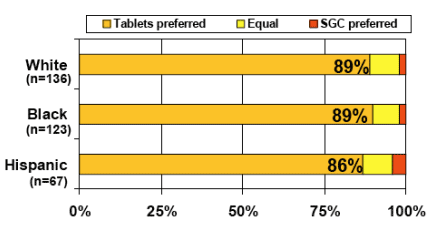
LPV/r Tablets benefits cited by respondents related to refrigeration, pill count, reduction in side effects, and food requirement
PreferenceTable 1. LPV/r Tablet Benefits cited by Respondents
The most popular benefit is not having to refrigerate the Kaletra tablets cited by 66% of Whites, 71% of Blacks, and 63% of Hipanics. The fewer pills was cited by 64% of Whites, 61% of Blacks, and 55% of Hispanics. "Does not give me bad side effects" was cited by 47% of Whites, 50% of Blacks, and 40% of Hispanics. "Not have to take with food" was cited by 37% of Whites, 49% of Blacks, and 36% of Hispanics.

No differences across the ethnic groups were noted in tolerability and satisfaction with LPV/r Tablets
Figure 3. Respondents' Perceptions of LPV/r Tablet Tolerability
82-87% of White (82%), Black (87%), and Hispanic (87%) patients responded that tolerability was "pretty good" (not bad side effects) or "great" (no side effects). About 40% responded tolerability was "great".
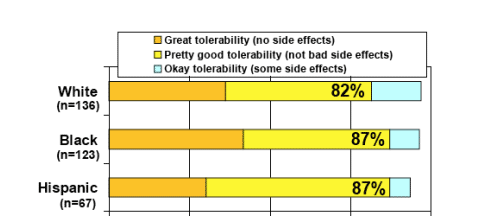
Overall, 63% (SGC) vs. 84% (Tablets) of respondents had pretty good to great tolerability.
No respondents indicated bad tolerability (i.e., "terrible"side effects) on LPV/r Tablets.
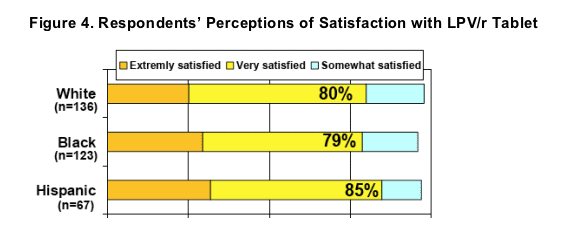
Overall, 60% (SGC) vs. 80% (Tablets) of respondents were very or extremely satisfied. 85% of Hispanics, 79% of Blacks, and 80% of Whites said they were extremely or very satisfied. 25-35% said they were extremely satisfied.
Of 332 respondents, only 1 (Black) respondent indicated "not at all being satisfied"with LPV/r Tablets.
For all ethnic groups, respondents had a significant improvements (p<0.05) in diarrhea frequency and severity after switching from LPV/r SGC to Tablets
Overall, 82% of respondents reported no diarrhea or improvement in diarrhea.
Overall, an additional 21% of respondents indicated no or rare diarrhea (p<0.05).
Overall, 76% of respondents reported no or rare antidiarrheal use (p<0.05).
Antidiarrheal use decreased in all groups, with significant decreases observed in White non-Hispanics, the ethnic group reporting the highest rates of antidiarrheal use.
Table 2. Improvement in Antidiarrheal Use and Diarrhea Severity and Frequency*
The proportions of respondents reporting severe diarrhea (tablets vs SGC): 7% vs 15% among Whites; 1% vs 8% among Blacks, 2% vs 12% among Hispanics; p<0.05.

All ethnic groups reported significant improvement in side effects with LPV/r Tablets
Figure 5. Improvement in Side Effects with LPV/r Tablets compared to SGC
The greatest improvements were observed in Black non-Hispanics with 85% reporting side effect are better when switched from LPV/r SGC to Tablets (p<0.05). 76% of Hispanics & 74% of Whites responded that side effects improved.

Table 3. Significant Improvement in Gastrointestinal Side Effects by Ethnicity
Relative risk are noted for statistically significant(p<0.05) improvements in 1) severity - respondent self-defined "severe"severity, and 2) frequency - 3+ times per week. Several GI side effects are improved with switching from LPV/r SGC to Tablets.
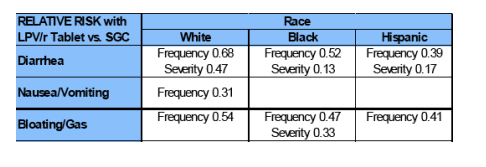
Self-reported adherence based on missed dosessignificantly improved after switching to LPV/r Tablets
Figure 6. Proportion of Respondents with No Missed Doses (100% Adherence)
All ethnic groups had improvements in 100% adherence (i.e., no missed doses in past week) after switching from LPV/r SGC to Tablets; statistically significant for Hispanics.

Figure 7. Mean Weekly Adherence based on Percentage of Doses Taken
Overall, the mean weekly adherence improved from 91% to 95% (p<0.05). Black non-Hispanics reported lower adherence than White non-Hispanics on either LPV/r formulations (p<0.05); socioeconomic influences were not assessed. For Black non-Hispanics (from 88% to 93%)and Hispanics (from 89% to 96%) the mean calculated weekly adherence significantly improved (both p<0.05).
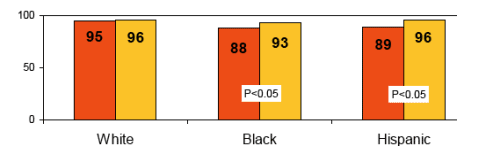
Figure 8. Proportion indicating Reason for Missed Doses by Ethnicity
Black non-Hispanics and Hispanics had significant decreases in missed doses due to avoiding side effects and not having food with them to take LPV/r (both p<0.05).
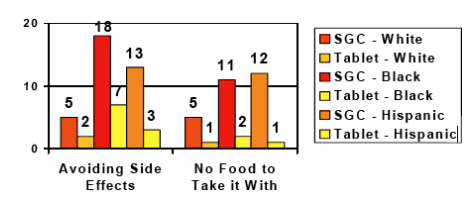
|
| |
|
 |
 |
|
|